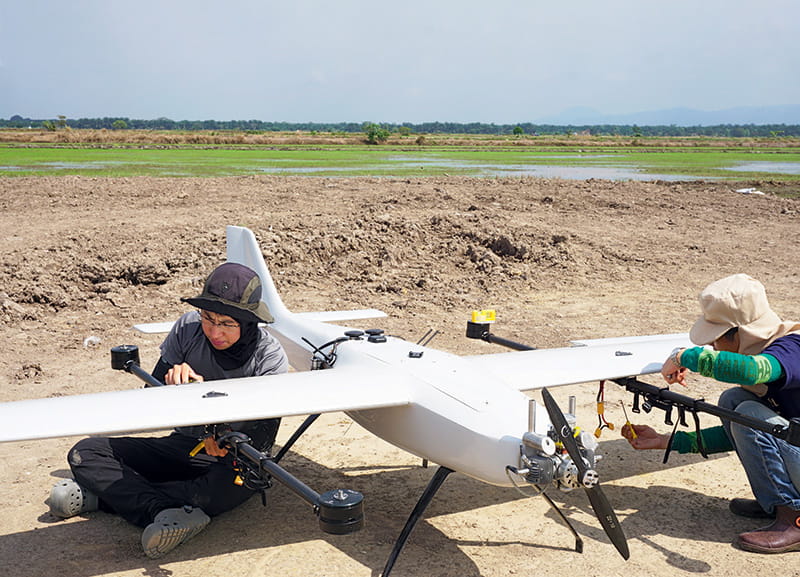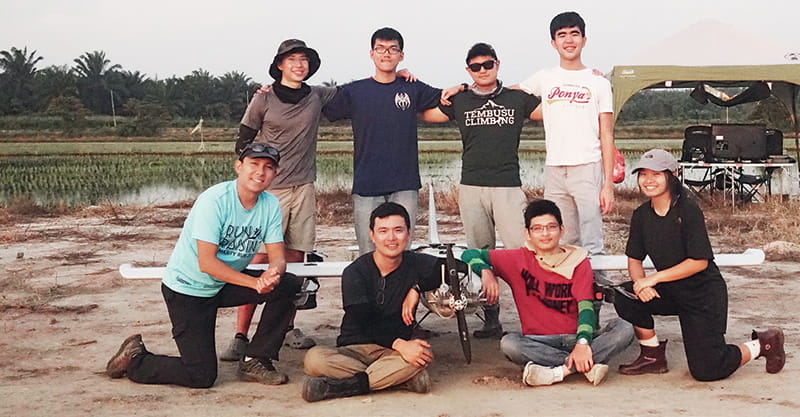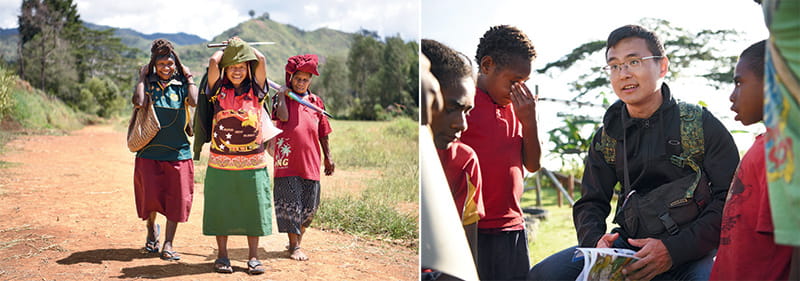Stories > A Helping Hand From The Skies
A Helping Hand From The Skies
Those living in the remote recesses of Papua New Guinea will soon be able to receive essential medical supplies, thanks to AT A GLANCE the efforts of one Singapore drone tech startup.
BY ALYWIN CHEW

Sim Zhi Min (left) has combined the concepts of a quad-copter and airplane to design Nemo, a quadplane that can operate unmanned in rough terrains of Papua New Guinea.
o many of us, travel is about letting the hair down and recharging the body and mind. For Sim Zhi Min, a trip to Papua New Guinea in 2016 proved to be a life-changing experience that put him on the road to becoming a business owner.
“I never imagined myself to be an entrepreneur,” says Sim, the co-founder of Yonah, a Singapore drone technology startup that aims to solve the logistical problems pertaining to the delivery of medical supplies in Papua New Guinea (PNG). “I always wanted to be a fighter pilot growing up,” he adds. “But I failed the medical examination when I was 18. So I decided I would go to school to learn how to make airplanes instead!”
Sim, who learnt about unmanned systems back when he was an undergraduate in the Faculty of Engineering at the National University of Singapore, was travelling in PNG to learn more about how Christian non-governmental organisation Mission Aviation Fellowship (MAF) conducted their humanitarian efforts on the island.
One of the things that struck him during the trip was the delivery of medical supplies to locals living in the remote regions and how it was often hampered by the rough terrain. “A 10-km hike across the mountainous jungles took more than a day to complete,” recalls Sim.
“Working With Foreign Government Agencies Has Taught Us That Sometimes Clarity Is Not A Given. We Need To Work To Turn The Grey Into Black And White And Help End-users Contextualise Their Problems.”
“We then heard anecdotes from the doctors about how outbreaks of various diseases like measles were common due to the logistical challenges associated with getting supplies across the terrain.”
It didn’t take long for Sim, who had previously worked as a design engineer for an unmanned systems company called Hope Technik, to realise that he could use drones to make a difference to the lives of others.
That same year, Sim and Ong Tian Chang, who was on that same trip in PNG, set up Yonah. The word in Hebrew means “dove”, the international symbol of peace.

Sim and his team have developed the quad-plane prototype called Nemo with the support of Singapore’s DSO National laboratories and international firms such as Bosch to provide drone service in remote areas.
A SLOW AND STEADY FLIGHT
Despite the perfect combination of Sim’s expertise in drones and Ong’s prior experience in working for a start-up, the initial challenges were aplenty. Besides engineering issues, a key member of the team departed abruptly, and the team ran into financing issues. There was little the duo could do except roll with the punches.
“It is hard to identify one particular challenge above the others, and it is perhaps the cocktail of all these that made this journey difficult but also rewarding,” says Sim. Today, Yonah is in much calmer waters, having secured major entities such as Singapore’s DSO National Laboratories and German firm Bosch as their main sponsors.
According to Sim, the past three years have largely been spent on designing a prototype that could meet the requirements for delivering supplies to hard-to-reach places. Called Nemo, the prototype looks more like a fixed-wing unmanned aerial vehicle (UAV) used for military purposes instead of the common drones, or quadcopters, that people use for leisure.
However, unlike conventional UAVs that need a runway to take off and land, Nemo is capable of vertical lift-off, which makes it suitable for carrying heavier loads and landing in undulating terrain where long and flat strips of land are scarce.
“A quadcopter is a rather rudimentary way of flying – it does so by applying more thrust from the spinning rotors than the weight. But it provides the flexibility of taking off and landing from any site,” explains Sim.
“A fixed-wing system, on the other hand, has a much superior payload and range capability but it requires either a runway or a complex take-off and landing infrastructure like a catapult launch system. We simply combined the two into what is called a quad-plane.” Powered by a fully autonomous system that relies on lidars, barometers and GPS, Nemo is capable of piloting itself through a pre-programmed flight path before landing within a half metre of its designated location.

from left: Yonah was set up when its co-founders realised how the people of Papua New Guinea’s remote areas faced challenges in receiving medicines and essential supplies; the tech firm has partnered with NGOs working in Papua New Guinea to make a positive impact on underserved local communities.
TAKING AID TO REMOTE CORNERS
The team’s current focus, says Sim, is working out a sustainable business model as delivering medical supplies alone won’t keep the company afloat. While Nemo has yet to be deployed for use in aid missions, companies have already been enquiring about whether Yonah’s drones can be used for humanitarian and disaster relief efforts as well as monitoring of illegal forestry activities. Yonah is also planning to expand its operations to Timor Leste in the near future, where it hopes to conduct medical cargo delivery services.
“My Earlier Perception Of Singaporeans Was That They Are Disciplined, Highly Educated And Intelligent. After Meeting Them, It Has Only Strengthened.”
According to Sim, Yonah aims to commence its delivery services within the next eight months. Some of the partners it has been working with include international aid organisations such as World Vision. At the same time, working with these global entities has proven to be a fruitful learning experience in terms of cultural exchange. For instance, Sim realised how the efficiency of Singapore’s bureaucracy is something most citizens take for granted.
“Working with foreign government agencies has taught us that sometimes clarity is not a given and it needs better understanding on our part. This will enable us to help end-users define and contextualise their problems, and work with them to leverage our technology to their benefit. To their credit, they are fast learners,” he says.
Yonah’s international peers have also learnt a thing or two about Singaporeans. David Mills, a doctor who works at the Kompiam Rural Hospital in Enga Province, Papua New Guinea, is one such person.
“My earlier perception of Singaporeans prior to meeting the Yonah team was that they are disciplined, highly educated and intelligent. After meeting them, it has only strengthened,” says Mills.
“Perhaps in this case it could be added that these guys from Yonah were not just focused on making money but helping people. This was very heartening to see.”
AT A GLANCEHealthcare resources in developing countries across Asia |
||||
0.6The average number of physicians for every 1,000 people in Southeast Asia, below the OECD average of 3.4 Organisation for Economic Cooperation and Development (OECD) 2015 |
2.8The supply of nurses per 1,000 population in the region, below the OECD average of 8.7 OECD 2014 |
|||
3.3beds per 1,000 population on average across Asia, with some of the lowest ratios in Pakistan at 0.6 and the Philippines at 0.5 OECD 2018 |
>1The number of scanners and MRI units per million population in Lao PDR, Pakistan, Sri Lanka, Myanmar and Cambodia, below the OECD average of 12 World Health Organization 2018 |
|||
1 UNITThe number of radiation machines per 10 million people in Myanmar, Cambodia, Pakistan, Bangladesh and Sri Lanka, below the OECD average of 7.2 OECD 2017 |
||||
